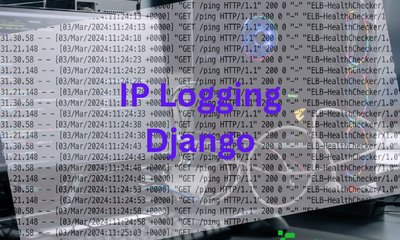高トラフィックアプリケーションにおける効率的なログ記録:Django IPアドレス検出の強化
By JoeVu, at: 2024年5月18日15:58
Estimated Reading Time: __READING_TIME__ minutes


はじめに
Djangoアプリケーション、特に認証済みユーザーのユーザーリクエストのログ記録は、セキュリティと分析に不可欠です。しかし、大量のデータを効率的に処理するという課題は、困難なものとなる可能性があります。この記事では、この課題に対する実践的な/商用ソリューションを探り、DjangoミドルウェアのカスタマイズとNGINXログを重視します。
課題:ユーザーリクエストのログ記録
認証済みユーザーが行ったすべてのリクエストをログに記録することは、特に金融アプリケーションにおいて、監視とセキュリティの目的のために重要です。これらのリクエストの送信元IPアドレスをキャプチャすることで、ユーザーのインタラクションと潜在的なセキュリティ侵害の詳細な分析が可能になります。これは、すべての安全なメカニズムの基本的なステップです。
課題:大量データの管理
1日に数十万件のリクエストがあると、大量のデータは、ストレージ、パフォーマンス、コストに大きな課題をもたらします。このデータを効率的に管理することは、システムの整合性と応答性を維持するために非常に重要です。
ソリューション
ソリューション1:Django-ipwareを使用したカスタムミドルウェア
ソリューションの概要:
django-ipwareを使用すると、各リクエストのIPアドレスを抽出してログに記録するカスタムミドルウェアを作成できます。このアプローチは、データベースの負荷を最小限に抑えながら、重要なデータがキャプチャされるようにします。
コードスニペット:
# django-ipwareをインストール
# pip install django-ipware
# ミドルウェアの例
from ipware import get_client_ip
class LogUserIPMiddleware:
def __init__(self, get_response):
self.get_response = get_response
def __call__(self, request):
client_ip, is_routable = get_client_ip(request)
if client_ip is not None:
# リクエストオブジェクトにIPを保存
request.user_ip = client_ip
# ここでは、IPを使用してログ記録ロジックやその他の操作を実装することもできます
response = self.get_response(request)
return response
利点:
- 軽量で統合が容易。
- 直接的なデータベースとのやり取りを最小限に抑えます。
欠点:
- データベースに負担をかけることなくIPデータを効率的にログに記録して管理するためのカスタムロジックが必要になります。
- アプリケーションをブロックする望ましくない例外を回避するために、
try/catchを使用してください
改善点:
- 書き込みが多い操作に最適化された別々のデータストアへの非同期ログ記録を実装して、プライマリデータベースへの負荷を軽減します。Celeryタスクは優れたツールです。
ソリューション2:包括的なリクエストログ記録のためのDjango-requestの活用
ソリューションの概要:
Django-requestパッケージは、DjangoアプリケーションでWebリクエストの追跡とログ記録を行うための堅牢なフレームワークを提供します。カスタムミドルウェアを必要とせずに、IPアドレスを含む詳細なリクエストデータをキャプチャするため、最小限の設定で包括的なログ記録を実装したい開発者にとって魅力的な選択肢となります。
コードスニペット:
まず、pipを使用してdjango-requestをインストールします。
pip install django-request
次に、settings.pyのINSTALLED_APPSにdjango_requestを追加し、そのミドルウェアをMIDDLEWARE設定に含めます。
INSTALLED_APPS = [
...
'django_request',
...
]
MIDDLEWARE = [
...
'request.middleware.RequestMiddleware',
...
]
django-requestは、IPアドレス、使用されたビュー、応答コードなど、着信リクエストを自動的にログに記録します。パッケージによって提供されるDjango管理インターフェースを通じて、これらのログを確認および分析できます。
利点:
- 既存のDjangoプロジェクトへのインストールと統合が容易。
- 追加のコードなしで、IPアドレスを含む幅広いリクエストの詳細を自動的にログに記録します。
- リクエストログの表示と分析のためのDjango管理インターフェースを提供します。
欠点:
- すべてのリクエストについて広範なリクエストデータを保存すると、データベースのサイズが大幅に増加し、パフォーマンスに影響を与える可能性があります。
- ログに記録するリクエストのフィルタリングや保存前のデータのサマリーなど、カスタムソリューションと比較して柔軟性が低くなります。
改善点:
- 古いログを定期的にクリーンアップするデータ保持ポリシーを実装して、データベースのサイズとパフォーマンスを管理します。
- ログ設定をカスタマイズして、重要度の低いリクエストを除外したり、特定の詳細のみをログに記録したりすることで、ストレージ要件を削減します。
ソリューション3:NGINXログの活用
ソリューションの概要:
NGINXでIPアドレスのログ記録を構成すると、データ収集の作業負荷が軽減され、大量のトラフィックを効率的に処理できます。
コードスニペット:
NGINXでIPログ記録を有効にするには、NGINX構成に次の行を追加します。
log_format main '$remote_addr - $remote_user [$time_local] "$request" '
'$status $body_bytes_sent "$http_referer" '
'"$http_user_agent" "$http_x_forwarded_for"';
access_log /var/log/nginx/access.log main;
この構成では、クライアントのIPアドレス($remote_addr)とその他のリクエストの詳細がキャプチャされます。
利点:
- Djangoアプリケーションからのログ記録をオフロードし、パフォーマンスを向上させます。
- 大量のデータのログ記録のための堅牢でスケーラブルなソリューションを提供します。
欠点:
- Django以外で追加の設定と構成が必要です。
- ログに記録されたデータへのアクセスと分析には、追加のツールやプロセスが必要になる場合があります。
改善点:
- ログのサイズと保持を効果的に管理するためのログローテーションとアーカイブ戦略を実装します。
- ログ管理ツールを使用してログデータをインデックス付けして分析し、直接データベースクエリを行わずにインサイトを提供します。
結論
トラフィック量の多いDjangoアプリケーションでは、効率的なリクエストログ記録は不可欠ですが、困難でもあります。この記事では、ターゲットを絞ったログ記録のためのdjango-ipwareを使用したカスタムミドルウェア、スケーラブルなシステムレベルのログ記録のためのNGINX、そして容易で包括的なログ記録設定のためのdjango-requestという3つの効果的なソリューションを紹介しました。各アプローチは、正確な制御から実装の容易さまで、独自の利点を提供し、さまざまなアプリケーションのニーズとパフォーマンスの考慮事項に対応しています。ログ記録を成功させる鍵は、特定の要件に最適なソリューションを選択し、システムのパフォーマンスを犠牲にすることなく詳細な洞察を確保することです。


![[Tips] Django useful commands and code snippets](/media/filer_public_thumbnails/filer_public/d3/62/d3622b0a-00dd-4400-b959-1734e11ad46a/tips_django_useful_commands_and_code_snippets.png__400x240_q85_crop_subsampling-2_upscale.jpg)


